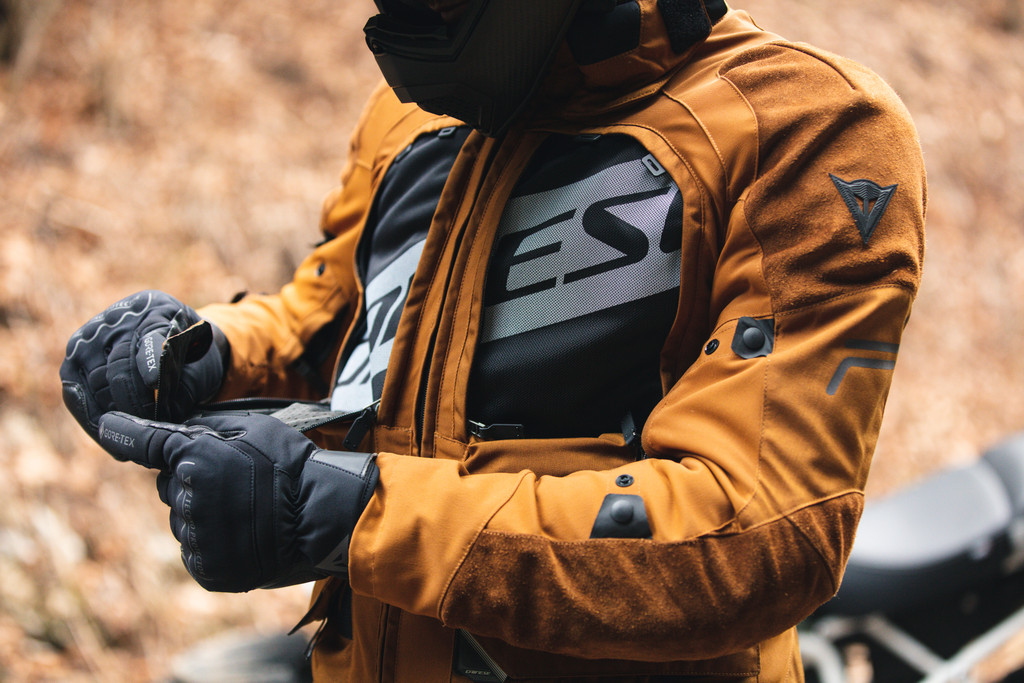There are many types of waterproof garment, each constructed in a different way and with different strengths and characteristics. And for many, figuring out which one best suits their needs is no easy task.
Let's start by saying that all waterproof garments integrate a waterproof membrane in one way or another, a very thin lining containing millions of tiny holes, such as the Gore-Tex®, Absøluteshell™ and the D-dry® membrane, developed internally by Dainese. These holes are small enough that water drops cannot penetrate, but large enough to allow the passage of hot and humid air generated by the body.
This is the advantage of a membrane, as it keeps us dry from the outside, by not letting water in, and on the inside, by allowing moisture to escape. Laminated jackets, jackets with a floating membrane and jackets with a removable membrane: the type of garment is defined by the way in which the membrane is integrated.
Let's clarify one thing right away, namely that no membrane is 100% waterproof. The performance of a membrane is measured in terms of its water column indication. This is a lab test in which a tube 2.5 cm in diameter is placed on a section of the membrane in question. Water is poured into the tube and we measure the amount that can be added before the pressure on the material becomes so great that the water penetrates it. A value of 20,000 mm, for example, means that the water column will be virtually 20 meters high before the pressure is such that water can penetrate the membrane.
At this point it is easy to understand that reducing the number of holes makes for a membrane with better water resistance. The flip side of the coin is that in this case the garment is less breathable.
Bear in mind that the classic effect of the water droplet that slides down fabric without impregnating it is not due to the presence of the membrane. This is in fact down to the DWR water-repellent treatment applied to the fabric. DWR stands for Durable Water Repellent, but the effect won’t last forever. It is a treatment that physiologically loses its effectiveness over time, due to usage and washing.
Laminated garments are traditionally popular among tourers, who want to be able to cross a continent taking on all conditions and with no fear of bad weather. To allow for this, their construction is particularly sophisticated . With laminated garments, the Gore-Tex®, Absøluteshell™ or D-dry® membrane is integrated in a unique way, to offer the best protection against the elements.
The structure of laminated garments sees a membrane coupled with the outermost fabric. The great strength of laminated garments is that, because water is immediately blocked by the membrane, they don’t reach the point of being soaking wet. The exterior may get wet on the surface, but it will never be soaked through. This is an advantage also if you need to wear the garment again a few hours later or at the end of the day, as there’s a high chance it will have dried out in the meantime.
The air vents on a laminated garment are more effective than those on garments with a floating membrane. This is because with laminated garments the particular construction of the openings allows for air to pass without it meeting the membrane shield. This kind of air vent requires a watertight zipper closure.
Garments with a D-dry® floating membrane are the simplest to make and are very popular due to their more affordable price tag. But an affordable price does not necessarily mean lesser performance. With this type of garment, the membrane is inserted between the exterior and the inner lining, so it cannot be removed.
The main advantage of garments with a floating membrane is that they offer greater protection from the cold than others. By nature, the air present between the exterior and the membrane acts as an effective insulator between the body and the atmosphere, keeping us warm even when temperatures become very cold.
These garments also offer excellent protection in the rain and will keep us dry for several hours. But it is after several hours of exposure to water that the garment really comes into its own. The garment will be soaked on the outside, giving us the unpleasant feeling of wearing a wet garment, even if in fact our body is still dry thanks to the membrane.

The big advantage of garments with a removable membrane is their versatility. The possibility to completely remove the membrane allows for different configurations of the garment, also playing with the large air vents. In this way , we have real all-season garments, with a Gore-Tex®, Absøluteshell™ or D-dry® membrane. Going from a winter configuration, with membrane, thermal lining and closed air vents, to a summer one, with no membrane or padding and with open air vents, is a quick and easy process. The ideal solution so as to have a year-round garment.
Garments with a removable membrane share some characteristics with those that have a floating membrane. Because the membrane is not coupled with the exterior, as it is with laminated garments, the risk is that hours of exposure to pouring rain will result in a garment that is soaking wet on the outside.
If you cover only limited miles, it is definitely an idea to consider purchasing a garment with a floating membrane, especially if you intend to use the motorcycle only in good weather. The more your mileage increases, the more likely you are to encounter rain. For those who use the motorcycle every day, even in winter, a laminated suit is definitely an excellent investment. For those who want a versatile jacket that adapts to every season, the ideal choice is a garment with a removable membrane and large air vents, perfect on even the hottest days.